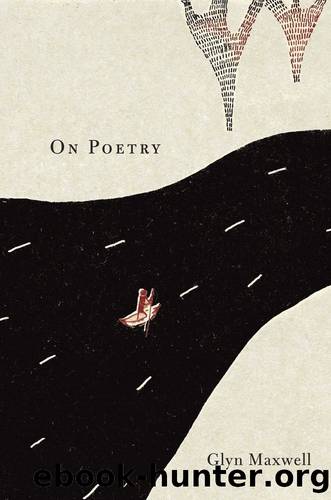On Poetry by Glyn Maxwell

Author:Glyn Maxwell [Maxwell, Glyn]
Language: eng
Format: epub
Tags: Composition & Creative Writing, English; Irish; Scottish; Welsh, European, Language Arts & Disciplines, Literary Criticism, Non-Fiction, Poetry
ISBN: 9781849435314
Google: yZHvs67AeBgC
Amazon: 0674970829
Publisher: Oberon Books
Published: 2012-05-28T23:00:00+00:00
Ay, but to die and go we know not where
If you then regularise your marks in space, the line elongates to something more like how it might be delivered:
Ay, but to die… and go we-know-not where…
A thousand actors will have them a thousand ways. The point is that the beats are as likely to fall through silence as upon sound. Meter to the poets who know what they’re doing is a silent skeletal frame on which a creature rides.
The fissure in writing poetry, the chasm between what I believe absolutely and doubt profoundly, is not between the ‘metrical’ (say Frost) and the ‘musical’ (say Pound) – which is a crude reduction of the work of both, albeit the kind of reduction writers in both camps have made ever since Robert and Ezra bickered on the pavements of Bloomsbury; the fissure is between having a governing aesthetic like either – or having no governing aesthetic at all, which leaves you with nothing but your next thought, or your latest feeling. That’s an impulse which waited ninety years to find its true literary form. It’s called a blog.
*
Poetry is creaturely. What survives in it echoes corporeal phenomena: the heartbeat and the pulse, the footstep and the breath. How it echoes is different in each language, in each culture, in each age: Beowulf, from around the year 1000, ‘Old English’, is unrhymed and alliterative, four beats to a line, a caesura (or gap) between them:
Hwæt! We Gardena in geardagum,
þeodcyninga, þrym gefrunon,
hu ða æþelingas ellen fremedon.
Oft Scyld Scefing sceaþena þreatum…
The Canterbury Tales, from the late 1300s, ‘Middle English’, is rhymed and metrical, five beats to a line:
Whan that aprill with his shoures soote
The droghte of march hath perced to the roote,
And bathed every veyne in swich licour
Of which vertu engendred is the flour;
Whan zephirus eek with his sweete breeth
Inspired hath in every holt and heeth
Tendre croppes, and the yonge sonne
Hath in the ram his halve cours yronne,
And smale foweles maken melodye,
That slepen al the nyght with open ye
(So priketh hem nature in hir corages);
Thanne longen folk to goon on pilgrimages…
Chaucer the well-travelled European helped to popularize that line in English; there’s nothing inevitable about it, it’s history, geography, migration, providence. The only reasonable generalisation is that certain forms survive extraordinarily intact, and the only worthwhile study the poet, as a maker, can make of poetry is – which forms survived and for what reason? Or, to turn that into practical gold as you dig it from the soil – which forms survive and for what purpose?
*
I wouldn’t want to be thought an incorrigible generalizer. There actually is a surviving rhymed poem in Old English, it was found in the Exeter Book, that 10th century collection with all the riddles in it. This poem that rhymes is known to scholars of Old English as ‘The Rhyming Poem’. Which kind of makes my point.
*
The lines below are the sixth and seventh stanzas of the most famous poem in English. It’s certainly the most popular, though the
Download
This site does not store any files on its server. We only index and link to content provided by other sites. Please contact the content providers to delete copyright contents if any and email us, we'll remove relevant links or contents immediately.
| Books & Reading | Comparative Literature |
| Criticism & Theory | Genres & Styles |
| Movements & Periods | Reference |
| Regional & Cultural | Women Authors |
4 3 2 1: A Novel by Paul Auster(11049)
The handmaid's tale by Margaret Atwood(6852)
Giovanni's Room by James Baldwin(5878)
Big Magic: Creative Living Beyond Fear by Elizabeth Gilbert(4723)
Asking the Right Questions: A Guide to Critical Thinking by M. Neil Browne & Stuart M. Keeley(4576)
On Writing A Memoir of the Craft by Stephen King(4213)
Ego Is the Enemy by Ryan Holiday(3991)
Ken Follett - World without end by Ken Follett(3972)
The Body: A Guide for Occupants by Bill Bryson(3802)
Bluets by Maggie Nelson(3711)
Adulting by Kelly Williams Brown(3671)
Guilty Pleasures by Laurell K Hamilton(3586)
Eat That Frog! by Brian Tracy(3514)
White Noise - A Novel by Don DeLillo(3436)
The Poetry of Pablo Neruda by Pablo Neruda(3367)
Alive: The Story of the Andes Survivors by Piers Paul Read(3311)
The Bookshop by Penelope Fitzgerald(3226)
The Book of Joy by Dalai Lama(3218)
Fingerprints of the Gods by Graham Hancock(3213)
